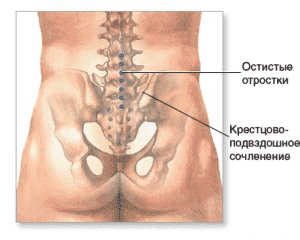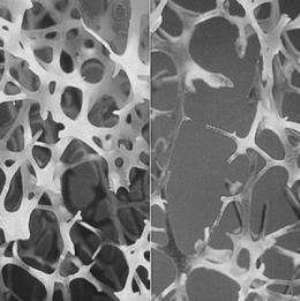Radiculitis is a pathology of tissues, in which compression or inflammatory processes are observed on the nerve endings. A person feels pain symptoms in the area of the affected nerve, sometimes the illness is accompanied by numbness and sudden muscle lethargy. There are many variations of this disease, but the most prevalent is radiculitis of the lumbosacral spine.
Causes of appearance
Radiculitis is not characterized as an independent disease. It includes a whole complex of symptoms, which appears when deformed or irritated spinal roots. They, leaving the channel of the spinal cord, rush to the hands, feet and other organs. The narrowed spinal holes, along which the nervous threads go, form the necessary conditions for pinching the roots.
Doctors came to the conclusion that the predominantly frequent cause of the formation of lumbosacral radiculitis is a disease such as osteochondrosis. The formation of this disease is accompanied by the defeat of the structure of the bones of the vertebral column, due to this intervertebral disc creates bulging or hernia. This formation exerts pressure on the adjacent nerve roots. As a result, a typical clinical picture of the disease appears.
The formation of a disease such as osteochondrosis is promoted by pathological changes of a degenerative-dystrophic nature that occur in bone tissues as a result of aging. With osteochondrosis, in addition to hernias, specific marginal proliferation – osteophytes – can occur.

These protuberances of the bone can easily damage the nerve roots and soft tissues, while contributing to the appearance of painful symptoms. When the disease develops, the stenosis of the canal of the spinal cord often occurs. This dysfunction can also spread to the narrowed spinal openings, from which, in turn, the neuro-fiber bundles emerge. Actually this is the main reason for squeezing fibers that develop the sciatic nerve in the vertebral column.
Sometimes there are other factors for the development of radiculitis:
- damage to the vertebral column;
- diseases with inflammation of the tissues directly near the spine;
- neoplasms of the peripheral nervous system;
- diseases of various human organs;
- a disease in which the structure of the spine is displaced;
- processes of inflammation in the joints;
- continuous uneven load on the vertebral column;
- disturbance of body functions;
- genetic predisposition;
- autoimmune diseases.
Consequently, radiculitis is a polyethological disease. The following exacerbations of pathology can cause: physical loads, sharp movements in the lumbar region, poisoning, temperature deviation from normal, colds.
Symptomatology
To the general or common symptomatology at a radiculitis carry:
- painful sensations of a different disposition and strength, which are usually exacerbated by sudden movements of the waist, with unsuccessful jumps, with lifting weights and uneven distribution of physical exertion;
- an increase in the painful syndrome with coughing, sneezing, abdominal tension;
- infringement at inclinations of a trunk sideways, forward or back;
- disturbance of the motor apparatus.
Depending on the level of damage, pain symptoms can be located in all kinds of areas of the human body: in the lumbar or gluteal regions, hips, muscles of the shins. In addition, pain can affect both sides of the human body. This is due to the nature of the swelling of the intervertebral discs.
If the nerves located under the 1 and 2 lumbar discs are damaged, there are lumbago in the buttocks and lower back, which pass along the back and lateral surface of the thigh. If the nerve endings of the 4-5 lumbar discs are damaged, the pain senses descend to the anterior part of the shin, the back of the lower leg, the outer ankle and the heel. In this case, it is impossible to flex the foot and toes.
The acute period of the disease lasts about 14-20 days. For diagnosis, a complex of characteristic symptoms is performed:
- Bechterew – there is an involuntary flexion of the lower limb from the side of the lesion, when a person passes from a lying position to a sitting position.
- Lasega – there is an increase in pain in the gluteal or lumbar region, the back surface of the limb, at the time of raising a straight leg in a supine position on the back.
- Dejerine – painful sensations increase when a person coughs or sneezes.
- Bonnet – on the lesion site, the wrinkle under the buttocks is smoothed.
- Neri – the painful symptomatology in the lower part of the human body increases with a sudden tilt of the head forward.
An effective remedy for pain and for the treatment of joints has been found:
- natural composition,
- without side effects,
- effectiveness, proven by experts,
- quick result.
For radiculitis, which is caused by a disease such as osteochondrosis, external transformations of the body are also characteristic: rectification of the bend of the spine in the waist and neck, an increase in curvature of the spine with bulging behind in the thoracic region, deviation of the spine with swelling towards the lesion.

When the pathological process of the disc between the 5 lumbar and 1 sacral vertebra may be the formation of scoliosis and convexity to the side, not affected by the disease.
The primary cause of infection of the lumbosacral nerve roots may become acute or infection in a chronic form. The pain increases when the torso is tilted forward and does not increase at the moment of loading on the spine. Violations of the vegetative department of the nervous system are also permissible. In a similar situation, when the process of inflammation wilts, the pain sensations cease to disturb rather quickly. On a fluorographic photograph, no deviations are noticeable.
Treatment options for radiculitis
To cure sciatica, doctors recommend using a more conservative method. In order to remove painful sensations and to fix the patient’s well-being, such methods are used:
- a strict recumbent mode is necessary at the moment of worsening of the patient’s state of health. Immobilization of the vertebral department can be achieved using corsets;
- anti-inflammatory treatment – very often to remove pain sensations apply drugs that belong to a group of non-steroidal anti-inflammatory drugs. There is an opportunity of their use in tablet, cream, injection kinds;
- muscle relaxants – these drugs eliminate spasm of muscles in the vertebral column and weaken the manifestation of the disease;
- exercise therapy – the implementation of a complex of training with a therapeutic task, which are focused on creating a supporting muscular corset;
- the help of a narrowly focused specialist – working with a specialist in the field of psychology and taking psychotropic pharmacological agents will help overcome a significant psychological burden that manifests itself with prolonged painful sensations.

Treatment with folk remedies:
- You need to take the root of horseradish and a small potato, then grate. Produced mass should be put on the back and wrapped with a towel. Keep this wrap for at least 1 hour, then it should be washed off.
- It should be as small as possible chopped hot pepper (2 pods) and mix it with 300 ml of ammonia. The resulting remedy should be rubbed into the lumbar region 2-3 times a day.
- It is necessary to spread the area of the waist with a small layer of honey and cover with a paper napkin. Top should be put 2-3 mustards and wrapped in plastic wrap, and then with a handkerchief made of wool. This wrap should be kept for at least 1 hour.
- Another effective method of treatment is to visit a Russian bathhouse. It is advisable to steam out the lumbar part quite strongly, while rubbing it with a broom, then for a few minutes rubbing soap into the loins (economic), at first carefully, and then with increasing strength. After going to the bathhouse, you must immediately lie down on the bed.
- If conservative methods do not bring the desired results or complications arise in the field of neurology, the operation is indicated. As a rule, it is directed at the elimination of intervertebral hernia, excision of osteophytes, resumption of vertebral body height.
Exercises with radiculitis of the lumbosacral spine
Many people who have radiculitis are wondering what is LFK and does it help?

LFK is a physical therapy. It can be prescribed in the form of preventive measures of exacerbations. The purpose of this exercise is to reduce the load on the affected area of the vertebral column. At an exacerbation of the disease, exercise gymnastics is strictly forbidden.
The exercise load should increase systematically. Before you start the exercises you need to do a simple warm-up, it will help warm up and prepare your muscles for further exercises. All physical exercises need to be done slowly and with caution, without sudden movements, twists and turns of the body.
If pain occurs, reduce the intensity of the workout, or suspend the exercise. Treatment of a chronic disease always includes exercise therapy. A certain set of training is appointed by a specialist.
Rules for exercise of exercise therapy
To reduce the maximum load on the vertebral column, all workouts are necessarily done in a sitting, lying position or on all fours. In certain situations, depending on how the patient feels, specialists can prescribe the training in a standing position.
All the exercises are initially, as a rule, focused on calming the muscles of the shoulders, hands, waist and back in general. Then in the workouts include physical loads that can contribute to strengthening the muscles.
In the presence of sensations of pain, the exercises exclude exercises during which the flexion and extension of the spine occurs. They can easily cause an increase in pressure inside the spine and worsen the patient’s health.
Contraindications:
- unsatisfactory state of health of the patient;
- acute period of the disease;
- violation of the normal functioning of the heart muscle.
LFK with radiculitis of the lumbosacral section is characterized by a small number of contraindications, but still it is not necessary to perform it alone. The best solution will be to consult a specialist doctor to select the optimal training package.



